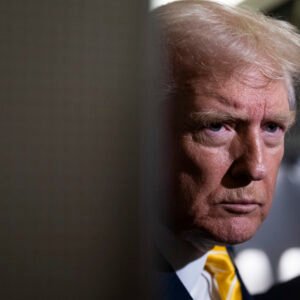There are few things I didn’t expect to see: a president cozying up to a young left-wing politician, or me paying much attention to his scarf. Yet here we are. The recent kerfuffle about Donald Trump supposedly copying Zohran Mamdani’s look is weirdly telling — not because of the clothes themselves, but because of what the whole moment reveals about image, politics, and how quickly something can be reshaped online.
A brief recap: people on social platforms claimed the president had copied a look Mamdani wore earlier — a turtleneck-and-blazer vibe, or so the story went. The problem? The image comparison that set off the chatter was shaky. Mamdani’s original photo, posted to his Instagram in 2023, actually showed him in a black turtleneck and gray blazer. Someone had altered that image to show a maroon turtleneck, and once that was pointed out, the claim that Trump was directly stealing Mamdani’s look lost its steam. Yet the narrative didn’t just vanish; it mutated. That’s the internet for you — messy, quick, and not always honest.
What I find interesting — and maybe you will, too — is not just whether a scarf or a turtleneck was pilfered. It’s the choreography of the encounter: Trump publicly cozying up to someone he’s been at odds with, Mamdani being asked on camera whether Trump is a fascist, the president patting him on the back and saying, “That’s okay, you can just say yes.” It’s performative, awkward, and kind of revealing. Politics often looks like theater, but sometimes the props do more talking than the lines.
A failed fashion statement, or something else?
Let’s be honest: Trump’s attempt at a trend — if we can call a tucked-in maroon scarf a “trend” — didn’t land. In photos taken later, the scarf had come loose and the president’s more familiar golf-shirt-and-quarter-zip showed through. That kind of slip turns what might have been a sly nod into a small, comedic collapse. Worse, the hat he wore clashed with the scarf, and his hair, well, it remained very much Trump hair: messy in a way that suggests either indifference or a stylist with a vendetta. The overall effect leaned less “slick reinvention” and more “trying and failing,” which is oddly human. I mean, I’ve tried an outfit that was going to be my big look and then tripped over a shoe lace — nothing glamorous about that.
Even earlier in the day, when he first introduced the outfit to reporters, the coat looked a bit too large. The scarf–as if it were attempting the job of a turtleneck—seemed to push his head forward, which produced a slightly cartoonish silhouette. If you squint, there was a mild resemblance to those exaggerated character designs from animated films — you know, the kind that’s memorable precisely because it’s a bit odd. That image stuck in people’s minds, probably more than any real discussion of policy or posture.
It’s tempting to write this off as just a clothing mishap. But clothing here is a shorthand for something larger: image management, alliances, and a desire to be comfortable in a changed narrative. Trump’s apparent chumminess with Mamdani — a person he’s publicly feuded with in the past — reads like a strategic move. Or a misstep. Or both. Politics is full of mixed messages, and this was a small, strangely personal one.
Also read: A Young Golfer’s Big Break — And the Debate That Followed
The odd theater of public interactions
And then there’s the exchange on camera when the question about fascism came up. Mamdani’s being put on the spot, Trump responding with a laugh and a back-pat: it’s staged spontaneity. This isn’t new — politicians often use informal gestures to change the tone of a moment — but it still feels off. The whole thing was equal parts charm offense and deflection. If you asked me, that pat was less about friendship than about control: a quick, intimate gesture that signals, “I’m the one who sets the mood here.”
You can see why people ran with the story that Trump copied Mamdani. It’s tidy, almost delicious: the conservative icon aping the youth-progressive politician he once fought. But the reality is less neat. The doctored images made the narrative easier to swallow, and social media, hungry for surprise and scandal, amplified it. So the truth — that the maroon turtleneck image was manipulated and Mamdani had been in a black turtleneck — got drowned out for a bit. That’s the small tragedy of digital discourse: the altered picture spreads faster than the correction.
Maybe Trump will actually borrow Mamdani’s style one day. Maybe he won’t. Either way, this episode shows how quickly symbols can be created and weaponized. A scarf becomes a stand-in for friendship, betrayal, mimicry, or mockery depending on who’s selling the story. This is not to say fashion is meaningless in politics; it’s just that the meaning people assign to tiny gestures often tells you more about their expectations than about the gestures themselves.
Small human details that matter
I’m often struck by how small moments stick with us. Not the big speeches or the policy briefings — those can be rehearsed into a kind of blandness — but the little gestures that feel genuine, or at least raw. A pat on the back, a scarf slipping, a forced laugh. These reveal cracks in the polish. They’re imperfect, messy, and oddly familiar. They remind me that public figures are still people — they try, they fail sometimes, and their attempts are photographed and then judged.
Also read: Soludo’s Sweep: How Divisions and Money Handed APGA the Win in Anambra
If nothing else, this episode gave us a pause — a moment to watch how people react, what they choose to amplify, and how quickly a story can get built on a shaky image. It also made the strange sight of Trump and Mamdani standing together into a minor cultural event, because the internet loves those sorts of juxtapositions. For my part, I’ll keep an eye out for the next sartorial stumble. Will it be a real homage? Or another manufactured story? Time will tell. Maybe Mamdani chuckled at the idea. Maybe he didn’t. Either way, the scarf has fallen — metaphorically, if not literally — and we watched.
















Leave a comment